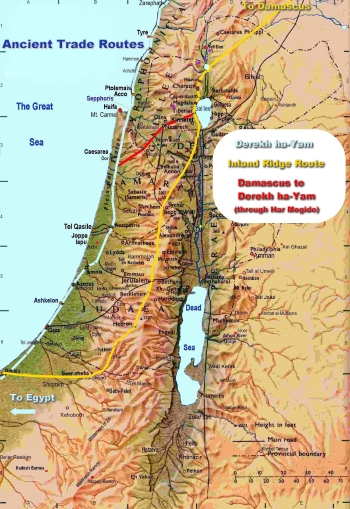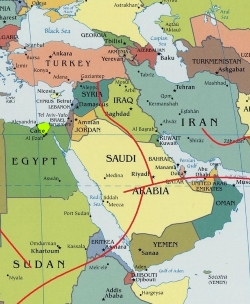Lëkh Lᵊkhâ 1st Eve (Mo•tzâ•eiꞋ Shab•âtꞋ Beginning Week)
AvᵊrâmꞋ Moves Family To Eil•onꞋ Mor•ëhꞋ, South Of ShᵊkhëmꞋ, Kᵊna•anꞋ

 |
 Har Grizim (lft) 750x563.jpg) |
 0250x141.jpg) |
After the death of TërꞋakh, ä' commanded AvᵊrâmꞋ to "get yourself going" out of Khâ•rânꞋ and go to Kᵊna•anꞋ where I will make you a powerful leader. I will bless those who bless you; and anyone who curses you I will damn. And in you shall all of the families of the a•dâm•âhꞋ become blessed.
So AvᵊrâmꞋ traveled with his caravan and encampment, his wife, Sâr•aiꞋ, and his nephew, Lōt, via the Inland Ridge Trade Route, through Damascus, Syria and into Kᵊna•anꞋ, passing around Yâm Ki•nërꞋët and continuing south into central Kᵊna•anꞋ to ShᵊkhëmꞋ, where AvᵊrâmꞋ set up his camp and pitched his tent in the nearby village of Eil•onꞋ Mor•ëhꞋ. There, AvᵊrâmꞋ envisioned ä' promising that He would bequeath the land to his descendants.
From Eil•onꞋ Mor•ëhꞋ, AvᵊrâmꞋ and his family continued moving south following the Inland Ridge Trade Route to Khë•vᵊr•onꞋ.
Famine In Kᵊna•anꞋ, AvᵊrâmꞋ Moves Family To Nile Delta, Egypt
 |
When a famine befell the land of Kᵊna•anꞋ, AvᵊrâmꞋ decided to move his family south and west into the Nile Delta of lower (northern) Egypt, where the annual flooding of the Nile made the Delta the food basket of the ancient world.
Unlike the lands in which AvᵊrâmꞋ and his family had lived to this point, Egypt was the ancient world's superpower – and had been for more than 1,000 years, ruled by a dictator Par•ohꞋ who could do whatever he wished. Rumors abounded of rulers murdering men married to beautiful wives in order to take their wives for themselves.1
AvᵊrâmꞋ was unaware of the Par•ohꞋ family's misguided belief that they were gods descended from gods by a "Holy Grail" divine bloodline that could not be mixed with "commoner" mortals. By their own beliefs, a Par•ohꞋ could only marry and reproduce within his own family's "divine blood" – usually a step-sister, a daughter of one of his Par•ohꞋ-father's several wives.
 Wahankh Intef II Limestone Funerary stele Middle Kingdom Dynasty XI Thebes 0250x333.jpg) |
So, although in some lands there was a danger of being killed because Sâr•aiꞋ was so desirable, unknown to AvᵊrâmꞋ, it was unlikely that the Egyptian Par•ohꞋ would compromise his claim of a Pharaonic "divine bloodline" underpinning his claim of rule by "divine right."
But because AvᵊrâmꞋ didn't know that, he feared being killed by the Egyptian Par•ohꞋ because Sâr•aiꞋ was so desirable. So, while in Egypt, he asked her to pose as his sister instead of his wife.
As a result, thinking she was AvᵊrâmꞋ's sister, the Egyptian officials who saw her recommended she be presented to Par•ohꞋ and took her to the palace to distance her from "commoner" mortals; presumably in preparation for eventual marriage to Par•ohꞋ. Because relative of a Par•ohꞋ must also be seen as distanced from "commoner" mortals, Par•ohꞋ also made AvᵊrâmꞋ a wealthy baron – with tzon, cattle, male donkeys, workers and maids, female donkeys and camels.
However, a contagious infection swept through Par•ohꞋ's household, and Par•ohꞋ blamed it on the new arrival: Sâr•aiꞋ. He soon learned that Sâr•aiꞋ was AvᵊrâmꞋ's wife, not his sister. But although Par•ohꞋ was mightily angry at AvᵊrâmꞋ, he shrewdly realized that it was politically unwise to publicly acknowledge that the Egyptian belief in "divine bloodline" and "divine right to rule," which kept the Pharaonic household in power, was so tenuous as to so nearly be compromised by a woman unqualified for deification.
Summoning AvᵊrâmꞋ, he dealt with the matter discreetly. "What have you done to me?" Par•ohꞋ demanded of AvᵊrâmꞋ. "Why didn't you tell me she is your wife? Why did you say, 'She is my sister,' putting me in danger of marrying a woman who is married to a mortal "commoner"? Take your wife and all of your belongings and get out of Egypt!"

Optional parental preparation:
- Watch the fictional movie, The Da Vinci Code.
- If you can access it, watch the History Channel UK video: Ancient Mysteries: Queen Pharaoh
- Track the journey of AvᵊrâmꞋ and his family, following the Fertile Crescent and then the Inland Ridge Trade Route, from what is today southern Iraq near the top of the Persian Gulf (Ur) north to southern Turkey near the Syrian border (Khâ•rânꞋ) south to ShᵊkhëmꞋ (Eil•onꞋ Mor•ëhꞋ), then down to Khë•vᵊr•onꞋ and, finally, to the Nile Delta in Egypt.
- Note 1 – AvᵊrâmꞋ's fears that the Par•ohꞋ might murder him in order to marry Sâr•aiꞋ were not without basis. Note that, approx. 1100 years later, Dâ•widꞋ ha-MëlꞋëkh similarly murdered one of his own top soldiers, Ur•i•yâhꞋ the Hittite, husband of Bat-ShëvꞋa, in order to marry her (Shᵊmu•eilꞋ Beit 11.1-12.25).

- When AvᵊrâmꞋ asked his wife to lie to the Egyptians, does that mean that lying is ok?
Questions you might anticipate that your child might raise and be prepared to discuss:
- What is an oak tree? A terebinth tree? (Google a photo)
- What is a stele?
- What does "femme fatale" mean? (French: fatal femininity; i.e. so beautiful as to be fatally dangerous)
- What was a Par•ohꞋ? (Hellenized to Pharaoh)
- What is the racist-supremacist belief in "divine blood"? (What is racism? What is supremacism?)
- What is a mortal?
- What is Hellenism? (Belief in the idol of
Ζεύςand related idols.) - What was the "Holy Grail"? (This is a Christian belief; and a simplification of a more cryptic belief in a "divine right" of those claiming to have a "divine bloodline" to rule as royal families. The simple explanation is that Christians believe the "Holy Grail" was the
Qi•dushꞋ cup used by RibꞋi Yᵊho•shuꞋa at his last PësꞋakh SeiꞋdër. However, the authors of the "Holy Grail" theory, called the "Knights Templar", had a more cryptic – secret – purpose. First, being Roman Christians (Hellenists), they believed in a divine man-godidol that they corrupted to interweave into their own idolatry, reinterpreting stories they heard from Hellenist Jews about RibꞋi Yᵊho•shuꞋa (whose mother's name was MiꞋrᵊyâm, Hellenized to "Mary"). Because Christians wrongly believed he was a man-god, their claim – that the woman who gave birth to their man-godtherefore had to be the sole vessel (grail) in the world who was the single wellspring coursing the "divine bloodline" – is also false. While most people superficially thought the "Holy Grail" was a mere Qi•dushꞋ cup, the Knights Templar kept their great secret: they believed that "Holy Mary" was the "Holy Grail"! It was "Holy Mary" and her "divine bloodline" that the Knights Templar sought – and claimed to have brought back to France and Europe. Many of the royal families of Europe, kings and queens, princes and princesses, claim a "divine right" to rule because, they falsely claim, they have descended from this "Holy Grail.") - What is a commoner? (In contrast to the "ruling class" of lords, etc., many of whom claim a "divine bloodline," an extension of the idolatrous notion of descent from the Hellenist "immortals" idols. A commoner has a non-divine, i.e., mortal, bloodline. All humans are commoners / mortals. There is no such thing as a "divine bloodline," which is, at its core, a racist and supremacist false claim.)
Google+ registered author & publisher

